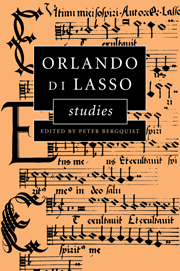Book contents
- Frontmatter
- Contents
- Preface
- List of abbreviations
- 1 Aspects of form in Orlando di Lasso's Magnificat settings
- 2 Orlando di Lasso and Andrea Gabrieli: two motets and their masses in a Munich choir book from 1564–65
- 3 Post-Tridentine liturgical change and functional music: Lasso's cycle of polyphonic Latin hymns
- 4 The salon as marketplace in the 1550s: patrons and collectors of Lasso's secular music
- 5 Lasso's “Standomi un giorno” and the canzone in the mid-sixteenth century
- 6 Lasso's “Fertur in conviviis”: on the history of its text and transmission
- 7 Orlando di Lasso and Rome: personal contacts and musical influences
- 8 Orlando di Lasso as a model for composition as seen in the three-voice motets of Jean de Castro
- 9 The madrigal book of Jean Turnhout (1589) and its relationship to Lasso
- 10 Modal ordering within Orlando di Lasso's publications
- 11 Correct and incorrect accentuation in Lasso's music: on the implied dependence on the text in classical vocal polyphony
- General index
- Index of Lasso compositions and printed sources
10 - Modal ordering within Orlando di Lasso's publications
Published online by Cambridge University Press: 18 December 2009
- Frontmatter
- Contents
- Preface
- List of abbreviations
- 1 Aspects of form in Orlando di Lasso's Magnificat settings
- 2 Orlando di Lasso and Andrea Gabrieli: two motets and their masses in a Munich choir book from 1564–65
- 3 Post-Tridentine liturgical change and functional music: Lasso's cycle of polyphonic Latin hymns
- 4 The salon as marketplace in the 1550s: patrons and collectors of Lasso's secular music
- 5 Lasso's “Standomi un giorno” and the canzone in the mid-sixteenth century
- 6 Lasso's “Fertur in conviviis”: on the history of its text and transmission
- 7 Orlando di Lasso and Rome: personal contacts and musical influences
- 8 Orlando di Lasso as a model for composition as seen in the three-voice motets of Jean de Castro
- 9 The madrigal book of Jean Turnhout (1589) and its relationship to Lasso
- 10 Modal ordering within Orlando di Lasso's publications
- 11 Correct and incorrect accentuation in Lasso's music: on the implied dependence on the text in classical vocal polyphony
- General index
- Index of Lasso compositions and printed sources
Summary
In recent years a number of scholars have devoted increasing attention to the structure of music prints in the sixteenth century. The reasons why composers or publishers decided on the order of the individual items in a collection are not always obvious. A set of Magnificats would of course appear in the order of the eight reciting tones that served as their cantus firmi, and some collections of motets were organized according to liturgical considerations, but the texts themselves, either Latin or vernacular, did not often imply a specific order when they were grouped in a publication. Harold Powers has articulated most clearly how traits of the music itself came to be used as an organizing factor. He observed that early sixteenth-century collections such as those of Petrucci have “no discernible musical basis for their arrangement,” while later in the century compositions came to be grouped according to three criteria: (1) whether cantus durus or cantus mollis governed, that is, whether the signature contained no flat or one; (2) whether the range was relatively lower or higher as shown by one of the two standard combinations of clefs, the so-called chiavette or “high” clefs and the normal or “low” clefs; (3) the final, expressed as the lowest note in the last sonority (or in modern terms, the root of the closing triad).
- Type
- Chapter
- Information
- Orlando di Lasso Studies , pp. 203 - 226Publisher: Cambridge University PressPrint publication year: 1999
- 2
- Cited by

